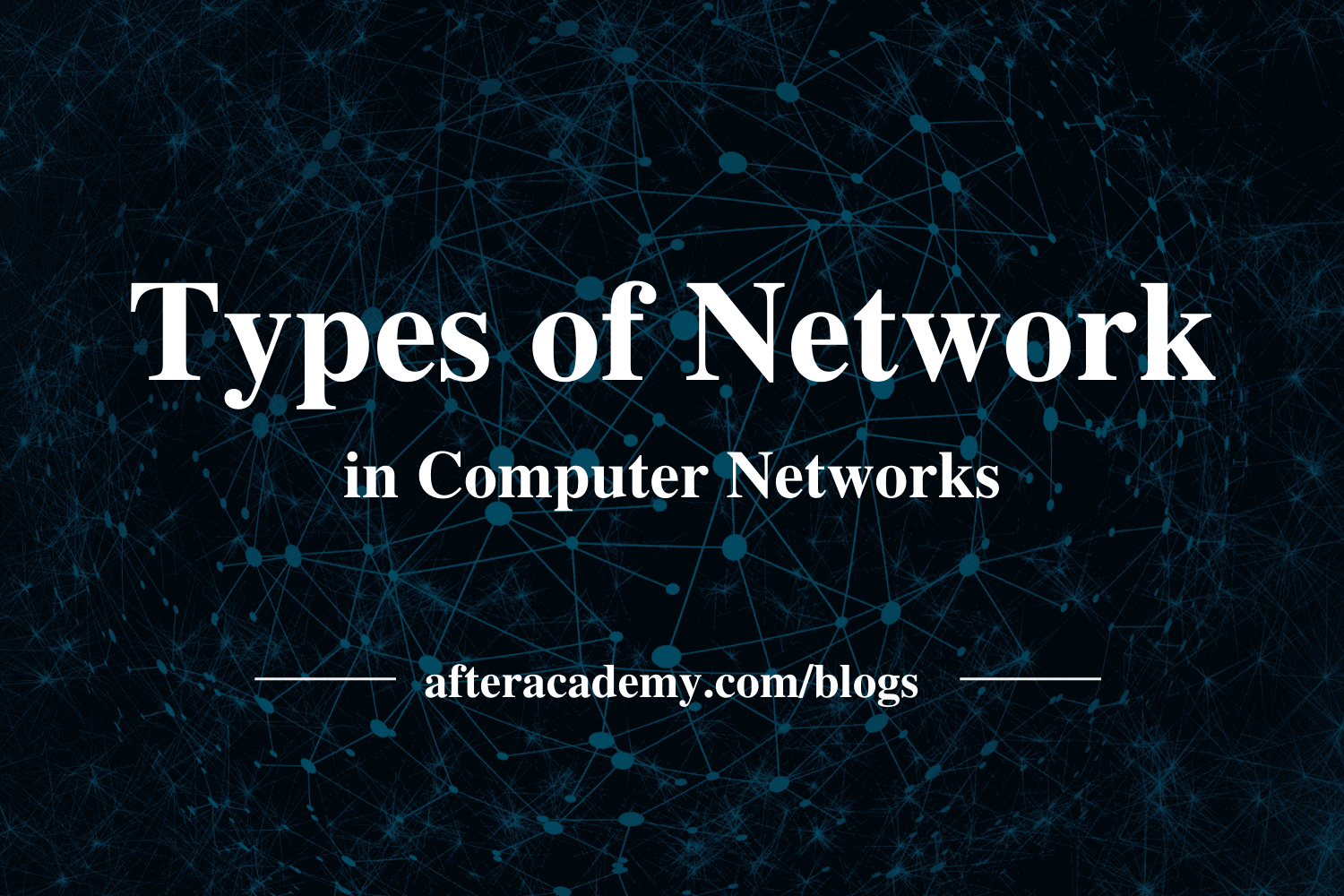What are the different types of network?

A computer network is a system in which multiple computers are connected to share information and resources. Computer network varies with each other based on their functionality, geography, ownership, and communication media used.
So, in this blog, we are going to learn about various types of computer networks based on geographical areas they cover, functionality, ownership, and communication media used.
A computer network can be divided into the following types, based on the geographical area that they cover, they are:
- LAN(Local Area Network)
- MAN(Metropolitan Area Network)
- WAN(Wide Area Network)
Now, let us study these networks one by one:
LAN(Local Area Network)
A local area network is a network, which is designed to operate over a very small geographical or physical area such as an office, building, a group of buildings, etc.
Generally, it is used to connect two or more personal computers through a communication medium such as coaxial, twisted-pair cables, etc. A LAN can use either wired or wireless mode of communication. The LAN which entirely uses wireless media for communication can be termed as WLAN(Wireless Local Area Network) .
Local Area Networks came under existence in around 1970s. IEEE developed the specifications for LAN. The speed of this network varies from 10mbps(Ethernet network) to 1gbps(FDDI or Gigabit Ethernet).
In other words, a LAN connects a relatively small number of machines in a relatively close geographical area. Bus, Ring, and Star topology are generally used in a local area network. In LAN, one computer can become a server in a star topology, serving all other computers called clients. Two different buildings can be connected very easily in LAN using a 'Bridge'.
Ethernet LAN is the most commonly used LAN. The speed of a Local Area Network also depends on the topology used. For example, a LAN using bus topology has a speed of 10mbps to 100mbps, while in ring topology it is around 4mbps to 16mbps. LAN's are generally privately owned networks.
Following are the functionalities of a Local Area Network:
- File Serving: In LAN, a large storage disk acts as a central storage repository.
- Print Serving: Printers can be shared very easily in a LAN by various computers.
- Academic Support: A LAN can be used in the classroom, labs, etc. for educational purposes.
- Manufacturing Support: LAN can support the manufacturing and industrial environment.
- High Reliability: Individual workstations might survive the network in case of failures.
Following are the advantages of a LAN:
- File transfer and file access
- Resource or peripherals sharing
- Personal computing
- Document distribution
- Easy to design and troubleshoot
- Minimum propagation delay
- High data rate transfer
- Low error rate
- Easily scalable(devices can be added or removed very easily)
Following are the disadvantages of a LAN:
- Equipment and support may be costly
- Some hardware devices may not inter-operate properly
MAN(Metropolitan Area Network)
A Metropolitan Area Network is a bigger version of LAN that uses similar technology as LAN. It spans over a larger geographical area such as a town or an entire city.
It can be connected using an optical fiber cable as a communication medium. Two or more LAN's can also be connected using routers to create a MAN. When this type of network is created for a specific campus, then it is termed as CAN(Campus Area Network).
The MAN spans over a geographical area of about 50km. The best example of MAN is the cable television network that spans over the whole city.
A MAN can be either a public or privately owned network. Generally, a telephone exchange line is most commonly used as a communication medium in MAN. The protocols that are used in MAN are RS-232, Frame Relay, ISDN, etc.
Uses of MAN are as follows:
- MAN can be used for connecting the various offices of the same organization, spread over the whole city.
- It can be used for communication in various governmental departments.
Following are the advantages of using MAN:
- Large geographical area cover as compared to LAN
- High-speed data connectivity
- The Propagation delay of MAN is moderate
Following are the disadvantages of MAN:
- It is hard to design and maintain a MAN
- MAN is less fault-tolerant
- It is costlier to implement
- Congestions are more in a MAN
WAN(Wide Area Network)
A Wide Area Network is the largest spread network. It spans over very large-distances such as a country, continent or even the whole globe. Two widely separated computers can be connected very easily using WAN. For Example, the Internet.
A WAN may include various Local and Metropolitan Area Network. The mode of communication in a WAN can either be wired or wireless. Telephone lines for wired and satellite links for wireless communication can be used in a wide area network.
In other words, WAN provides long distance transmission of data, voice, image, and video, over a large geographical area. A WAN may span beyond 100km range. It may be privately or publicly owned.
The protocols used in WAN are ISDN(Integrated Service Digital Network), SMDS(Switched Multi-Megabit Data Service), SONET(Synchronous Optical Network), HDLC(High Data Link Control), SDLC(Synchronous Data Link Control), etc.
The advantage of WAN is that it spans over a very large geographical area, and connects a huge mass of people.
Following are the disadvantages of WAN:
- The propagation delay is more in a WAN
- The data rate is low
- The error rate is high
- It is very complex to design a WAN
These are the types of network according to geographical area.
Following are the types of network, based on functionality:
- Client-Server Network: Client-Server network is a network in which a client runs the program and access data that are stored on the server. In this kind of network, one computer becomes the server, serving all other computers called clients.
- Peer-to-Peer Network: Peer-to-Peer network facilitates the flow of information from one peer to another without any central server. In other words, each node on a server acts as both client and server.
Following are the types of network, based on Ownership:
- Private Network: A private network is a network in which various restrictions are imposed to secure the network, to restrict unauthorized access. This type of network is privately owned by a single or group of people for their personal use. Local Area Network(LAN) can be used as a private network.
- Public Network: A public network is a network that has the least or no restrictions on it. It can be freely accessed by anyone, without any restrictions. This type of network is publicly owned by the government or NGOs. Metropolitan Area Network(MAN) and Wide Area Network(WAN) can be used as a public network.
Following are the types of network, based on Transmission Media:
- Bound/Guided Media Network: Bounded/Guided media can also be referred to as wired media. This kind of networks provides a physical link between two nodes connected in a network. The physical links are directed towards a particular direction in the network. Co-axial, twisted pair, optical fiber cable, etc. can be used in such networks for connectivity. Local Area Network(LAN) and Metropolitan Area Network(MAN) can be used as a Bound/Guided media network.
- Unbound/Unguided Media Network: Unbounded/Unguided media can also be referred to as wireless media. This kind of network does not need any physical link for electromagnetic transmission. Radio waves, Microwaves, Infrared, etc. can be used in such networks for connectivity. Metropolitan Area Network(MAN) and Wide Area Network(WAN) can be used as an Unbound/Unguided media network.
This is all about the various types of computer networks. Hope you learned something new today.
That's it for this blog.
Do share this blog with your friends to spread the knowledge. Visit our YouTube channel for more content. You can read more blogs from here .
Keep Learning :)
Team AfterAcademy!





